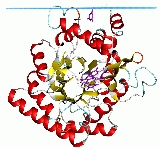
Dihydroorotate dehydrogenase
Encyclopedia
Dihydroorotate dehydrogenase is an enzyme
that catalyzes the fourth step in the de novo biosynthesis of pyrimidine. It converts dihydroorotate to orotate:
Human dihydroorotate dehydrogenase is a ubiquitous FMN
flavoprotein
. In bacteria (gene pyrD), it is located on the inner side of the cytosolic membrane
. In some yeasts, such as in Saccharomyces cerevisiae
(gene URA1), it is a cytosolic protein, whereas, in other eukaryotes, it is found in the mitochondria.
has been shown to inhibit DHODH. Human DHODH has two domains: an alpha/beta-barrel domain containing the active site and an alpha-helical domain that forms the opening of a tunnel leading to the active site. Leflunomide has been shown to bind in this tunnel. Leflunomide is being used for treatment of rheumatoid and psoriatic arthritis.
Mutations in this gene have been shown to cause Miller syndrome
also known as Genee-Wiedemann syndrome, Wildervanck-Smith syndrome or post axial acrofacial dystosis (POADS).
Enzyme
Enzymes are proteins that catalyze chemical reactions. In enzymatic reactions, the molecules at the beginning of the process, called substrates, are converted into different molecules, called products. Almost all chemical reactions in a biological cell need enzymes in order to occur at rates...
that catalyzes the fourth step in the de novo biosynthesis of pyrimidine. It converts dihydroorotate to orotate:
- (S)-dihydroorotate + O2
 orotate + H2O2
orotate + H2O2
Human dihydroorotate dehydrogenase is a ubiquitous FMN
Flavin mononucleotide
Flavin mononucleotide , or riboflavin-5′-phosphate, is a biomolecule produced from riboflavin by the enzyme riboflavin kinase and functions as prosthetic group of various oxidoreductases including NADH dehydrogenase as well as cofactor in biological blue-light photo receptors...
flavoprotein
Flavoprotein
Flavoproteins are proteins that contain a nucleic acid derivative of riboflavin: the flavin adenine dinucleotide or flavin mononucleotide ....
. In bacteria (gene pyrD), it is located on the inner side of the cytosolic membrane
Cell membrane
The cell membrane or plasma membrane is a biological membrane that separates the interior of all cells from the outside environment. The cell membrane is selectively permeable to ions and organic molecules and controls the movement of substances in and out of cells. It basically protects the cell...
. In some yeasts, such as in Saccharomyces cerevisiae
Saccharomyces cerevisiae
Saccharomyces cerevisiae is a species of yeast. It is perhaps the most useful yeast, having been instrumental to baking and brewing since ancient times. It is believed that it was originally isolated from the skin of grapes...
(gene URA1), it is a cytosolic protein, whereas, in other eukaryotes, it is found in the mitochondria.
Clinical significance
The anti-inflammatory drug leflunomideLeflunomide
Leflunomide is a medication of the DMARD type, used in active moderate to severe rheumatoid arthritis and psoriatic arthritis. It is a pyrimidine synthesis inhibitor.-Basic chemical, pharmacological, and marketing data:...
has been shown to inhibit DHODH. Human DHODH has two domains: an alpha/beta-barrel domain containing the active site and an alpha-helical domain that forms the opening of a tunnel leading to the active site. Leflunomide has been shown to bind in this tunnel. Leflunomide is being used for treatment of rheumatoid and psoriatic arthritis.
Mutations in this gene have been shown to cause Miller syndrome
Miller syndrome
This condition is also known as the Genee-Wiedemann syndrome, Wildervanck-Smith syndrome or postaxial acrofacial dystosis . The incidence of this condition is not known but it is considered extremely rare...
also known as Genee-Wiedemann syndrome, Wildervanck-Smith syndrome or post axial acrofacial dystosis (POADS).

